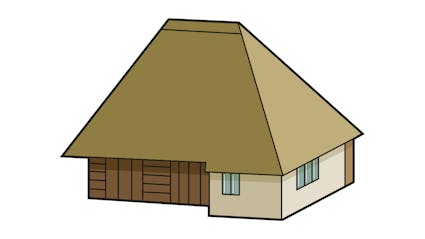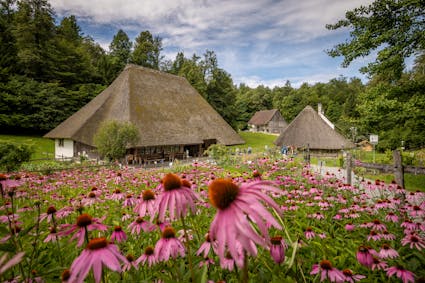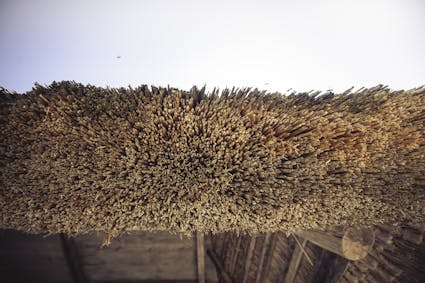221 – Farmhouse from Oberentfelden, Argovia, 1609
The house from Oberentfelden bears witness to those former thousands of large multipurpose houses with tent-like straw roofs.

A 400-year Building Project
Dendrochronology (analysis of tree rings) reveals that the trees for the wood of the oldest sill beams in the house were felled in 1609. In 1627 the house underwent its first renovation and got a “stock”: a masonry storeroom adjoining the kitchen. A whole house of stone masonry can also be called a “Stock” as evidenced by the Villnachern house (211). The farmer kept his most valuable goods in the “Stock” of the Oberentfelden house, especially his seed stock – the most treasured valuable of all, which had to be protected against both fire and thieves. In the following 400 years the house was repeatedly patched and adapted to changing needs. The derelict house came to Ballenberg in 1984–1985. Here we reconstructed the house with its large wide roof as it would have looked in the 17th and 18th centuries.

Worries Overhead
Houses of this type can still be found in Switzerland. However the roofs are no longer thatched but tiled. Agriculture has changed: soon enough the long stalks of manually harvested rye straw disappeared. This straw was particularly well-suited for “soft roofs”. There arose not only a lack of material but also of craftsmen who knew how to use it – namely thatchers – and their skills. Furthermore, straw roofs were a fire risk. In the 19th century insurance companies raised their premiums sharply for thatched roof houses. This, too, contributed to the loss of the traditional and hitherto widespread roofing material – who wanted to pay more whilst bearing the cost of intensive maintenance? As a compromise, this house from Oberentfelden is roofed with a straw-reed thatch that has an expected life of about 50 years.

Architectural Dinosaurs
Roofs thatched with straw or reeds are well represented in Hungary, northern Germany, England and Africa. There also used also to be many in the Ajoie (near France), in Geneva and especially in the Swiss Midlands. Only a few remain: the house from Oberentfelden bears witness to those former thousands of large multipurpose houses with tent-like straw roofs. Their aura was such that until 1850–1900 many an Argovian village resembled an army of tents.
“Pure Swissness” tour
The "hands-on-house"
This farmhouse is full of surprises to discover and explore! Find out what the specially chosen historical items in the building were once used for. Try some ancient handicrafts or lend a hand with the daily chores around the house. Or how about slipping into historical clothing and experiencing the magic of the past? All this and much more awaits you here!

Ballenberg
Swiss Open-Air Museum
Museumsstrasse 100
CH-3858 Hofstetten bei Brienz
Company holidays
24 December 2025 to 11 January 2026
Opening hours Administration
3 November 2025 to 8 April 2026
From Monday to Friday
8.30 am to 11.30 am
1.30 pm to 4.30 pm
Opening hours
9 April to 1 November 2026
10 am to 5 pm daily